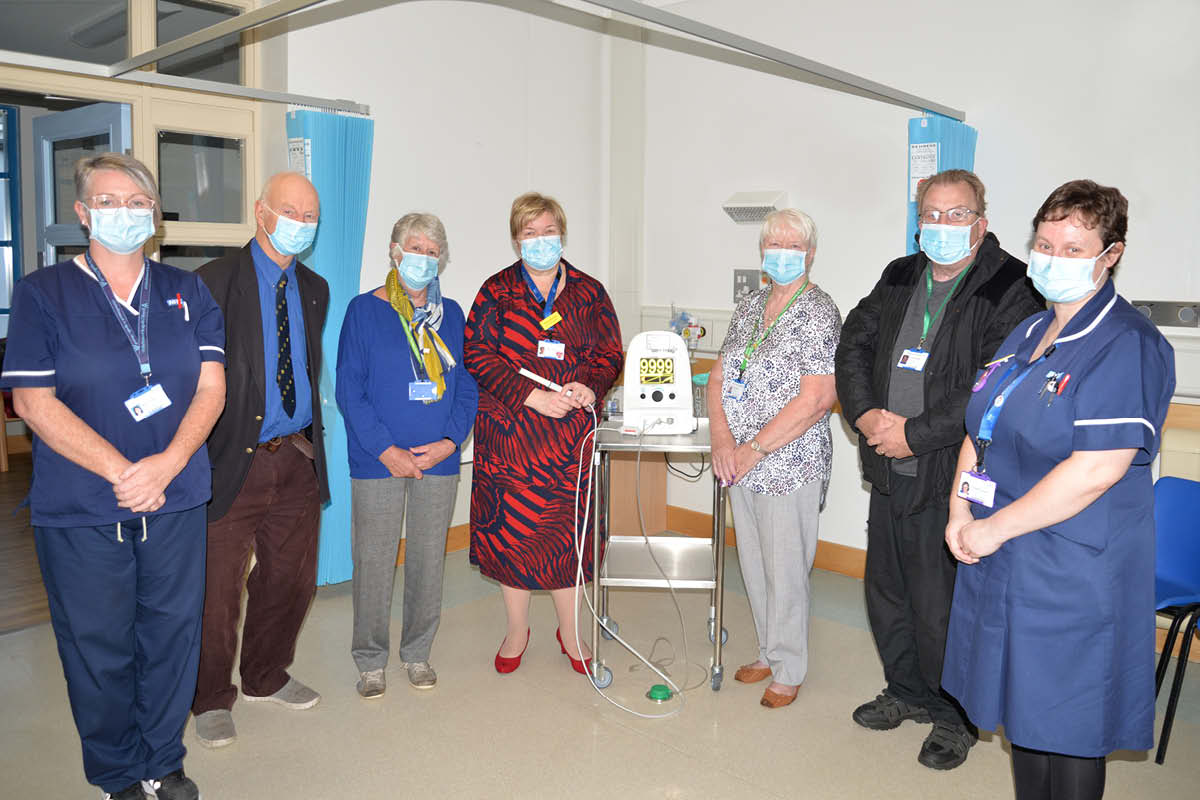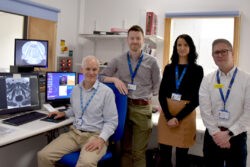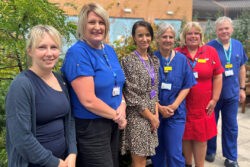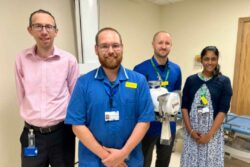Breast surgeons at Musgrove Park Hospital have introduced a procedure that identifies a small tumour, while also improving the experience of patients.
The Sentimag method of surgery has been in use at Yeovil Hospital since 2017 – it was the second hospital in the country to use the procedure – and is now available at Musgrove, thanks in part to a kind donation by the hospital’s League of Friends and its donors.
In order to have their breast cancer treated, patients need to have a tumour removed from our breast and a sample taken from the first draining armpit lymph gland from the cancer, also known as the sentinel node.
Instead of having a wire placed in the breast on the day of surgery, this less invasive procedure is where breast radiologists place a tiny magnetic bead, called Magseed, into the tumour at any time before surgery, which is more comfortable for the patient.
To identify the sentinel node in the armpit, patients get a tiny injection, called Magtrace, from the radiology team at the time of their pre-operative assessment, that travels to the lymph gland. This can be given up to 30 days before their surgery.
The Sentimag procedure was brought to Musgrove by consultant breast surgeon Miss Maria Bramley, who said it has transformed the way breast surgery is organised at the hospital.
“If a breast cancer is identified in a patient through a mammogram or via our screening programme, it’s usually tiny so we need to look at the best way of identifying the tumour and removing the lump through an operation,” she said.
“Our patients are understandably anxious on the day of their surgery so using Sentimag is really great, as they won’t need to have all the intensive preparation work done on same day.
“Instead, the Magseed magnetic bead will be placed in the tumour and a Magtrace injection is given to identify the first draining armpit lymph gland from cancer. These can both be given during the pre-operative assessment, allowing more efficient scheduling of surgery.”
Surgeons at Musgrove have embraced the new procedure, which has improved the accuracy of localising the breast cancer and reduced the rates of margin involved.
Maria continued: “The standard way of carrying out breast surgery has typically involved bringing the patient to our breast care unit on the day of their surgery for a mammogram or ultrasound before we place a wire into the area of the breast that’s affected.
“The wire would have been taped up on the side of the patient’s breast and they’d be transferred back to the ward whilst they wait for their operation slot.
“If a patient has an invasive breast cancer, they’d need to have a sample taken from their armpit lymph gland, which would provide an accurate measure of the stage of the tumour.
“This would traditionally have involved two injections – one on the morning of the surgery using a radioisotope, which travels in the body’s lymph vessels, and then a second injection of blue dye on the operating table.
“But this provided us with several challenges. With the radioactive isotope coming from Bristol in a van on the day of surgery, it meant that we couldn’t do a sentinel node biopsy before 11am, or place the wire inside the breast before the operating list started at 9am, potentially leading to operating time being lost due to logistics.
“It also meant that our breast radiology colleagues were spending time in the morning putting in wires when their time could be better served running breast clinics.
“And, most importantly, there is a small risk that the blue dye could cause an anaphylaxis – a potentially life-threatening allergic reaction – but through using Magtace, we’ve been able to remove this risk.”
When Maria moved to Somerset from Manchester in January 2021, it was her ambition to introduce Sentimag at Musgrove, but as the hospital’s theatres are so spread out across the site, more than one machine was needed.
“We’re so thankful to our League of Friends for kindly donating money to buy an additional Sentimag machine, on top of the NHS trust-funded machine,” added Maria.
“It has meant that we can use this really innovative technique which brings us into line with our colleagues at Yeovil Hospital, who have already been using it for a little while.
“I am very grateful to my surgical and radiological colleagues for embracing this technique and to all the breast clinical nurse specialist and pre-op teams for facilitating it.”
Miss Caroline Osborne, a consultant breast surgeon at Yeovil Hospital, said great care was taken to ensure the surgery was comfortable for patients.
“It has taken us a couple of years to refine our injection technique so that it is not uncomfortable for our patients and yet is highly effective at identifying the sentinel node,” Caroline said.
“Our team at Yeovil Hospital worked closely with Endomag, the company that developed Sentimag and Magtrace, when introducing the new technology to ensure we were all trained and skilled in the procedure.”
With her experience and expertise in the technology, Miss Osborne went on to advise the innovation team at the National Institute for Clinical Effectiveness in creating national guidance on the use of Magtrace to identify axillary sentinel nodes in patients with breast cancer.
Miss Salma Naseem, who is also a consultant breast surgeon at Yeovil Hospital, said the Sentimag procedure has had a huge impact on the care and treatment of patients since it was introduced at Yeovil in 2017.
“Sentimag has improved both the experience of our patients and the efficiency of our theatres,” she said.
“The Magtrace is injected by our surgeons, usually at the follow-up visit when planning surgery, and at the same time our radiology colleagues do their best to accommodate the Magseed placement. By doing this we are avoiding a second journey to hospital for the patient.
“It also gives our patients more flexibility, as placing a Magseed means an operation can be more easily re-scheduled if the patient isn’t able to attend on the day due to unforeseen circumstances.
“And since the licence for Magseed placement in the body has increased from one month to an undefined period, it has increased our flexibility even further.
“I’m very proud that we’ve achieved this by effective communication and good team working at Yeovil Hospital, and it’s great news that more patients at Musgrove Park Hospital are now able to benefit from this technology too.”
Peter Renshaw, Chairman of the League of Friends Musgrove Park Hospital, said: “I want to thank everyone in the community who has made the funding possible by donating money, leaving a legacy or purchasing items from the shop.
“For over 60 years funding from the League of Friends has enabled the hospital to invest in state-of-the-art equipment for the benefit of patients and colleagues.”







